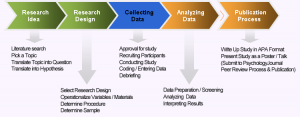Research Process
Partido, B.B.
Why is this important for me to know?
All research studies go through the same process. It is important for healthcare professionals to understand the general  process for original research.
process for original research.
The Research Process
The research process involves the following 5 steps:
- Research idea: Pick a topic and formulate a research question. Conduct a thorough review of the literature to make sure that your research question has not been answered already. If it has already been answered, modify your research question and conduct a literature review. When you have found a gap in the literature, you can finalize your research question and hypotheses.
- Research design: Define your control (independent) and outcome (dependent) variables and ensure there is a relationship between the variables. Determine the best way to measure the variables and ensure that the measurement of your outcome variables must align with existing theoretical concepts. The sample size must be large enough to generalize your results to the larger target population. This information becomes part of the research protocol which explains the rationale, objectives, methods, and procedures. After the research study has been designed, an IRB application can be submitted to ensure the ethical treatment of your research participants.
- Data collection: After IRB approval has been granted, participants are recruited and enrolled with informed consent. The data is then coded in statistical software for analysis.
- Data analysis: The data undergoes various levels of statistical analysis to validate the process and make inferences from the data.
- Reporting results: There are multiple methods to disseminate the research results. The main methods is through publication in a peer-reviewed journal. After submitting a manuscript that meets the journal’s publication criteria, the manuscript undergoes a blinded review process that entails comments from peer-reviewers and revisions from the author. After the peer-reviewers accept the final revisions and recommend the publication of the manuscript, the journal editor provides the final approval for publication. The manuscript remains in press until it is officially published. During this process, the author may choose to provide oral or poster presentations at various professional conferences. The author can gain feedback from viewers which can aid the author when writing the manuscript.
- Repeat: After discovering new knowledge, new research questions and potential future studies are identified. This provides others with an identified gap in the literature and potential pathway for a new research study.